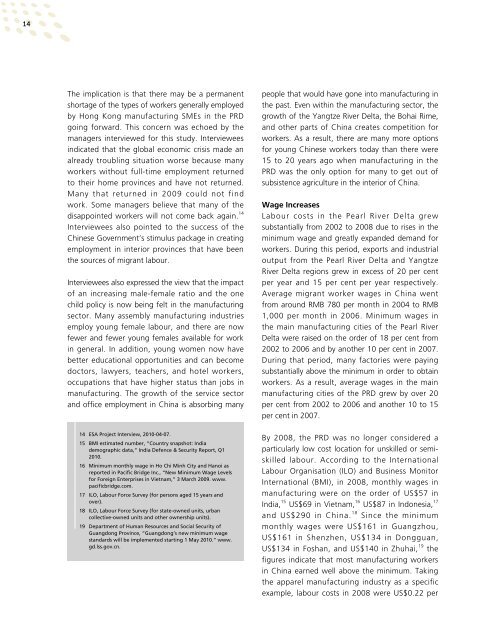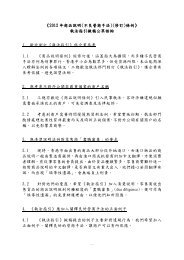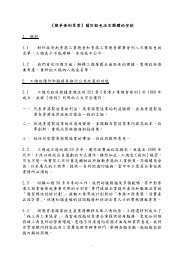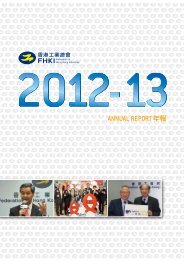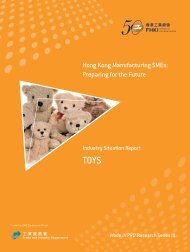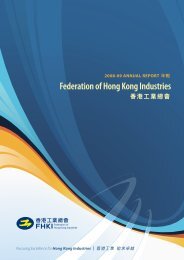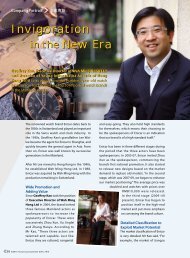Hong Kong Manufacturing SMEs: Preparing for the Future
Hong Kong Manufacturing SMEs: Preparing for the Future
Hong Kong Manufacturing SMEs: Preparing for the Future
- No tags were found...
You also want an ePaper? Increase the reach of your titles
YUMPU automatically turns print PDFs into web optimized ePapers that Google loves.
14The implication is that <strong>the</strong>re may be a permanentshortage of <strong>the</strong> types of workers generally employedby <strong>Hong</strong> <strong>Kong</strong> manufacturing <strong>SMEs</strong> in <strong>the</strong> PRDgoing <strong>for</strong>ward. This concern was echoed by <strong>the</strong>managers interviewed <strong>for</strong> this study. Intervieweesindicated that <strong>the</strong> global economic crisis made analready troubling situation worse because manyworkers without full-time employment returnedto <strong>the</strong>ir home provinces and have not returned.Many that returned in 2009 could not findwork. Some managers believe that many of <strong>the</strong>disappointed workers will not come back again. 14Interviewees also pointed to <strong>the</strong> success of <strong>the</strong>Chinese Government’s stimulus package in creatingemployment in interior provinces that have been<strong>the</strong> sources of migrant labour.Interviewees also expressed <strong>the</strong> view that <strong>the</strong> impactof an increasing male-female ratio and <strong>the</strong> onechild policy is now being felt in <strong>the</strong> manufacturingsector. Many assembly manufacturing industriesemploy young female labour, and <strong>the</strong>re are nowfewer and fewer young females available <strong>for</strong> workin general. In addition, young women now havebetter educational opportunities and can becomedoctors, lawyers, teachers, and hotel workers,occupations that have higher status than jobs inmanufacturing. The growth of <strong>the</strong> service sectorand office employment in China is absorbing many14 ESA Project Interview, 2010-04-07.15 BMI estimated number, “Country snapshot: Indiademographic data,” India Defence & Security Report, Q12010.16 Minimum monthly wage in Ho Chi Minh City and Hanoi asreported in Pacific Bridge Inc., “New Minimum Wage Levels<strong>for</strong> Foreign Enterprises in Vietnam,” 3 March 2009. www.pacificbridge.com.17 ILO, Labour Force Survey (<strong>for</strong> persons aged 15 years andover).18 ILO, Labour Force Survey (<strong>for</strong> state-owned units, urbancollective-owned units and o<strong>the</strong>r ownership units).19 Department of Human Resources and Social Security ofGuangdong Province, “Guangdong’s new minimum wagestandards will be implemented starting 1 May 2010.” www.gd.lss.gov.cn.people that would have gone into manufacturing in<strong>the</strong> past. Even within <strong>the</strong> manufacturing sector, <strong>the</strong>growth of <strong>the</strong> Yangtze River Delta, <strong>the</strong> Bohai Rime,and o<strong>the</strong>r parts of China creates competition <strong>for</strong>workers. As a result, <strong>the</strong>re are many more options<strong>for</strong> young Chinese workers today than <strong>the</strong>re were15 to 20 years ago when manufacturing in <strong>the</strong>PRD was <strong>the</strong> only option <strong>for</strong> many to get out ofsubsistence agriculture in <strong>the</strong> interior of China.Wage IncreasesLabour costs in <strong>the</strong> Pearl River Delta grewsubstantially from 2002 to 2008 due to rises in <strong>the</strong>minimum wage and greatly expanded demand <strong>for</strong>workers. During this period, exports and industrialoutput from <strong>the</strong> Pearl River Delta and YangtzeRiver Delta regions grew in excess of 20 per centper year and 15 per cent per year respectively.Average migrant worker wages in China wentfrom around RMB 780 per month in 2004 to RMB1,000 per month in 2006. Minimum wages in<strong>the</strong> main manufacturing cities of <strong>the</strong> Pearl RiverDelta were raised on <strong>the</strong> order of 18 per cent from2002 to 2006 and by ano<strong>the</strong>r 10 per cent in 2007.During that period, many factories were payingsubstantially above <strong>the</strong> minimum in order to obtainworkers. As a result, average wages in <strong>the</strong> mainmanufacturing cities of <strong>the</strong> PRD grew by over 20per cent from 2002 to 2006 and ano<strong>the</strong>r 10 to 15per cent in 2007.By 2008, <strong>the</strong> PRD was no longer considered aparticularly low cost location <strong>for</strong> unskilled or semiskilledlabour. According to <strong>the</strong> InternationalLabour Organisation (ILO) and Business MonitorInternational (BMI), in 2008, monthly wages inmanufacturing were on <strong>the</strong> order of US$57 inIndia, 15 US$69 in Vietnam, 16 US$87 in Indonesia, 17and US$290 in China. 18Since <strong>the</strong> minimummonthly wages were US$161 in Guangzhou,US$161 in Shenzhen, US$134 in Dongguan,US$134 in Foshan, and US$140 in Zhuhai, 19 <strong>the</strong>figures indicate that most manufacturing workersin China earned well above <strong>the</strong> minimum. Taking<strong>the</strong> apparel manufacturing industry as a specificexample, labour costs in 2008 were US$0.22 per


